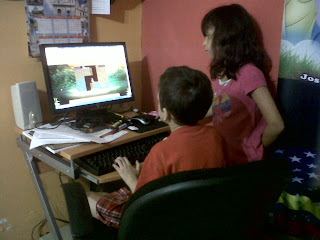The week is coming to an end and after taking a look at
all of the blogs, I feel like I´ve been travelling around the world already. I have
never had the chance to be in such an international group. People from
neighboring countries (my case) like Paraguay and Uruguay and from so far away places like
South Korea and Taiwan. I believe this is the perfect formula to see what´s the
world doing regarding technology into the classroom. In this regard, I would
love to sense the pulse of the degree of implementation that you are actually doing.
Specifically the way you are using not only blogs but other web tools as well. In
my opinion, blogs are 'work
spaces'
on which other web tools can be adapted. Blogging should not be seen as the final
goal but as the beginningof the stepladder, setting the ground for cooperation, participation and
mutual learning, whereby other web tools could be used, specifically web
2.0 tools. We have seen already, that we can network our blogs
by using Blogger’s gadgets.
Just click on your Layout, then on Add Gadget and you will be amazed at how
many options you can get for your blog. Needless to say those gadgets are
cosmetic elements to liven up the dynamics of a blog whereas Web 2.0 tools
involve the operation of software to achieve certain tasks. For example, a
talking tool like Voki
(avatar maker) can be posted on a blog. I am pretty sure we are going to
cover these tools in the near future.
On the other hand, it took me just a bit to adapt to
the 3 work platforms that are being used for running this 'Web Skills' course. We have a lobby page (run by adm) and 2
activity sites (with user privileges) which required either password or
authorization. Three separate spaces + participants' blogs. This whole bunch may require
a dashboard :D I like the way it is. Likewise, I found it very
thoughtful to have us debate about our own Grounding Rules for Discussion.
That´s an excellent idea and it shows a very democratic approach to deal with
this issue, and I am very grateful for participating. How wonderful would it be if many of our proposals as teachers were
conducted like that. This is something
worth looking up to.
Also, I must acknowledge the efforts made by our core
instructor , Janine, to be able to guide such a diverse group so smoothly and
effectively. I can´t but imagine being on hers shoes. I have enjoyed being a student
and tried to be on the side of the learner, but sometimes I just can´t resist
to switch my view from a teacher perspective. Janine has been able to cope with
such a demanding circumstance. Being able to read and post messages and
answering through the 2 platforms + many blogs must not be so easy. I,
respectfully, picture her like the following pic ;) And believe me, I have been
there!!
What have I learn so far? I have experienced
first-hand how it is to embrace a new learning environment from the point of
view of a student. Metacognitively speaking, I am taking notes on the steps and
procedures a teacher must follow when implementing an online course. UO people
have set an excellent example. What kinds of e-mails to send first, how to
present the information, how to keep participants from cognitive indigestion
and the types of praises to deliver to promote a healthy learning atmosphere.
Being a teacher I couldn´t resist making a list of my
classmates and add some bio based on the information from their introductions.
I did it to have a “big picture” and be able to track my postings on the blogs
by the weeks. I have seen them all, they are all great, but I have not been
able to give an answer to everyone yet. I hope to do that as the time goes by.
By the following weeks I should be able to pay a visit to each one of
you. Please, feel free to use this table if you find it useful. I plan to
check-mark my postings so that I make sure not to leave anyone behind. As for today, these are the blogs I have
visited, skimmed and replied. Am I missing anyone? I appologize if I do.
Name
|
Country/
level
|
Blog visited
|
Reply posted
|
|
1
|
Janine Sepulveda
|
USA – Core Instructor
|
√
|
|
2
|
Chiara Morandi
|
Paraguay - Elementary
|
||
3
|
Hyesun LEE
|
South Korea – High School
|
√
|
|
4
|
Mohini
Bachani
|
India – University
|
√
|
|
5
|
Batool Albashier
|
Sudan- University
|
√
|
√
|
6
|
Erika
uribe
|
Mexico – High School
|
√
|
|
7
|
María del Carmen Serrano Fernández
|
Spain-
Secondary School
|
√
|
|
8
|
Ilham
Zeroual
|
Morocco – High
School
|
||
9
|
Andrea Argüelles
|
Mexico
– High School
|
√
|
|
10
|
Maria
de Fátima da Costa da Silva
|
Portugal –
Teacher for 20 yrs.
|
||
11
|
Dzemal Spago
|
Bosnia
- University
|
√
|
|
12
|
Naif
Salem Alabri
|
Oman – Junior
High
|
√
|
|
13
|
Juan
Garcia
|
? – H.School/Univ
|
||
14
|
Fernando
Baiza
|
Mexico –
Univ/Teens
|
√
|
|
15
|
Diana
Lira
|
Mexico
– Basic level
|
||
16
|
Roxana Sordo
|
Uruguay – ?
|
√
|
√
|
17
|
Po-Yu
Pen (yorpong)
|
Taiwan
- Elementary
|
√
|
|
18
|
Samira
Bakr
|
Egipt -
University
|
√
|
|
19
|
Shirish Krishnarao More
|
India
- Tertiary
|

